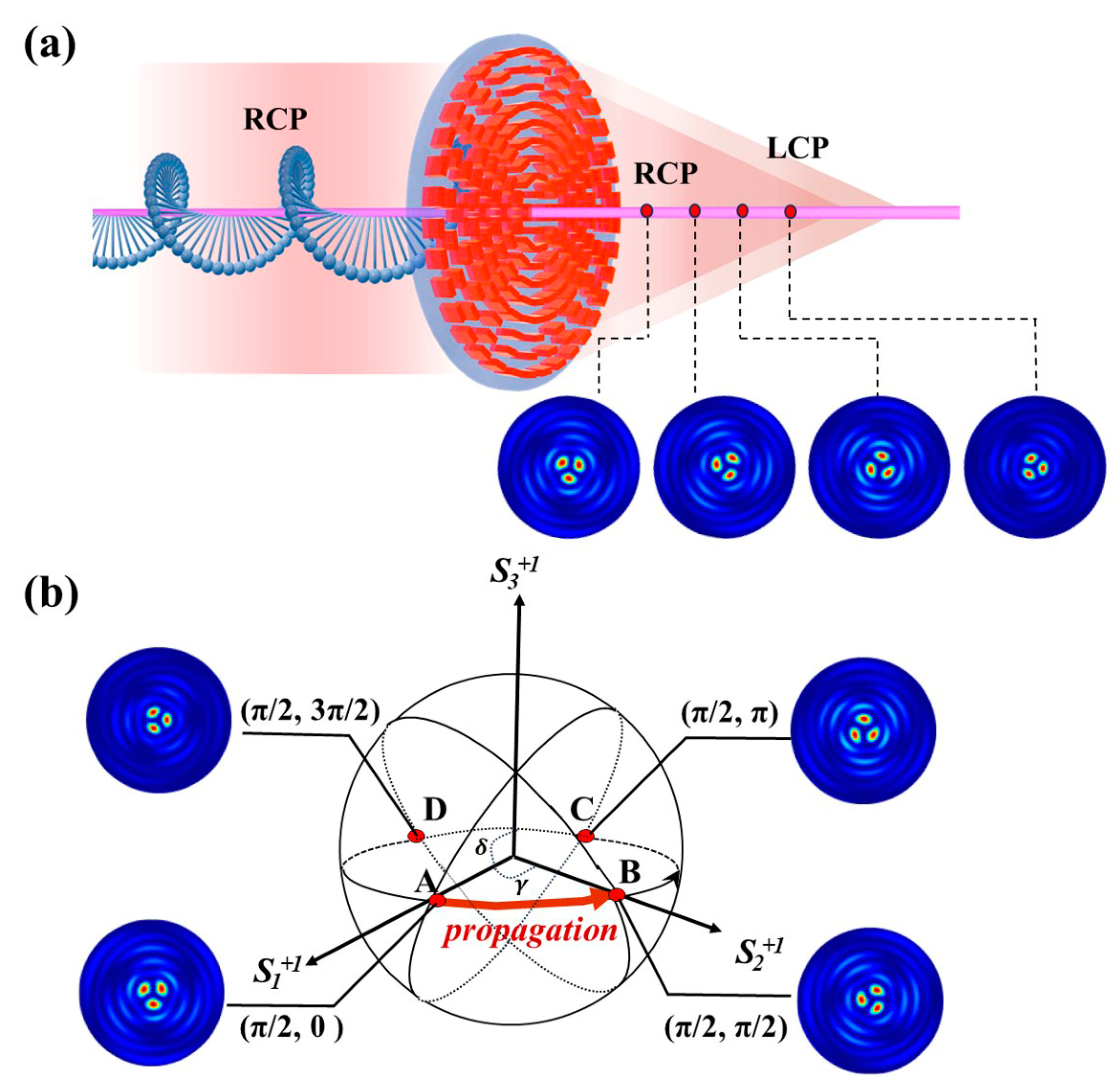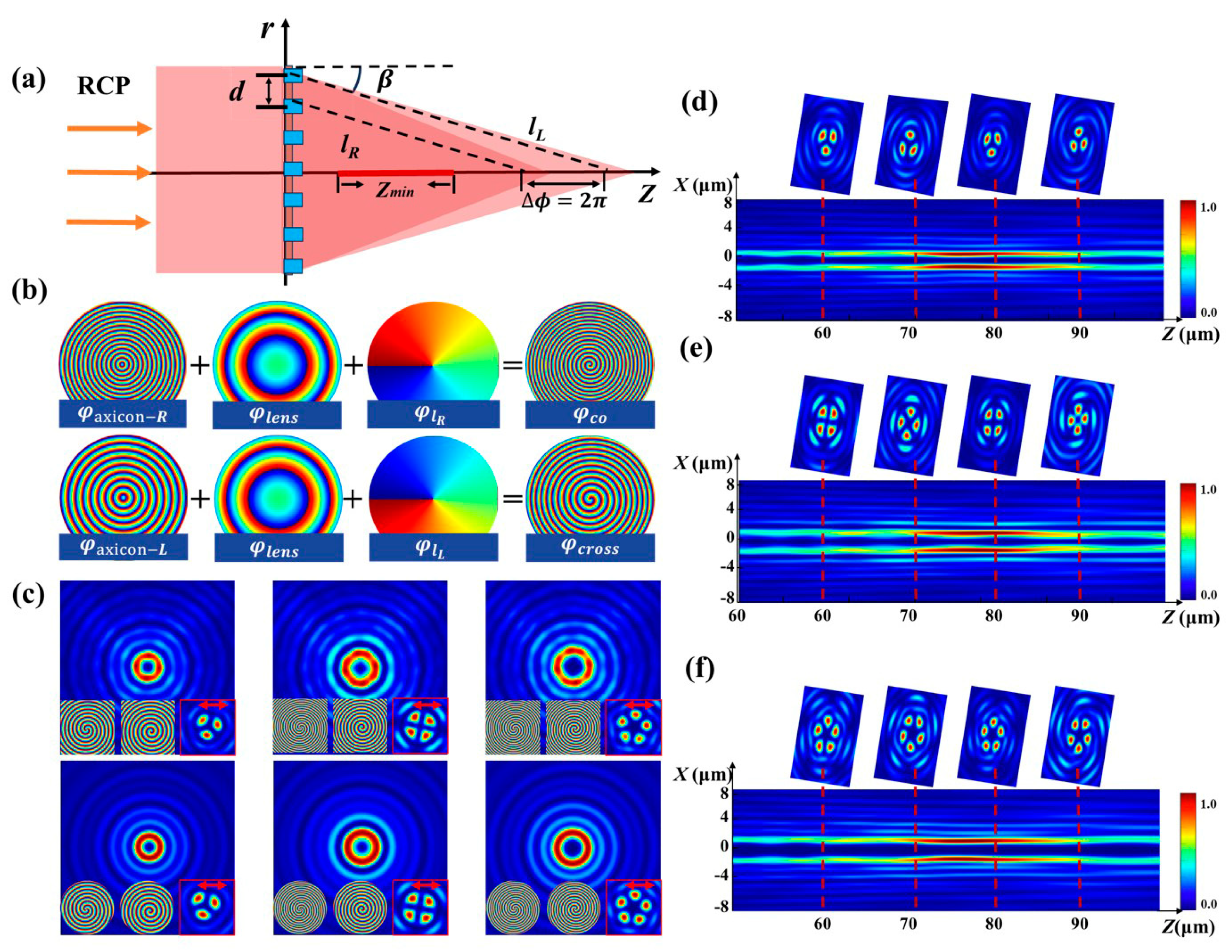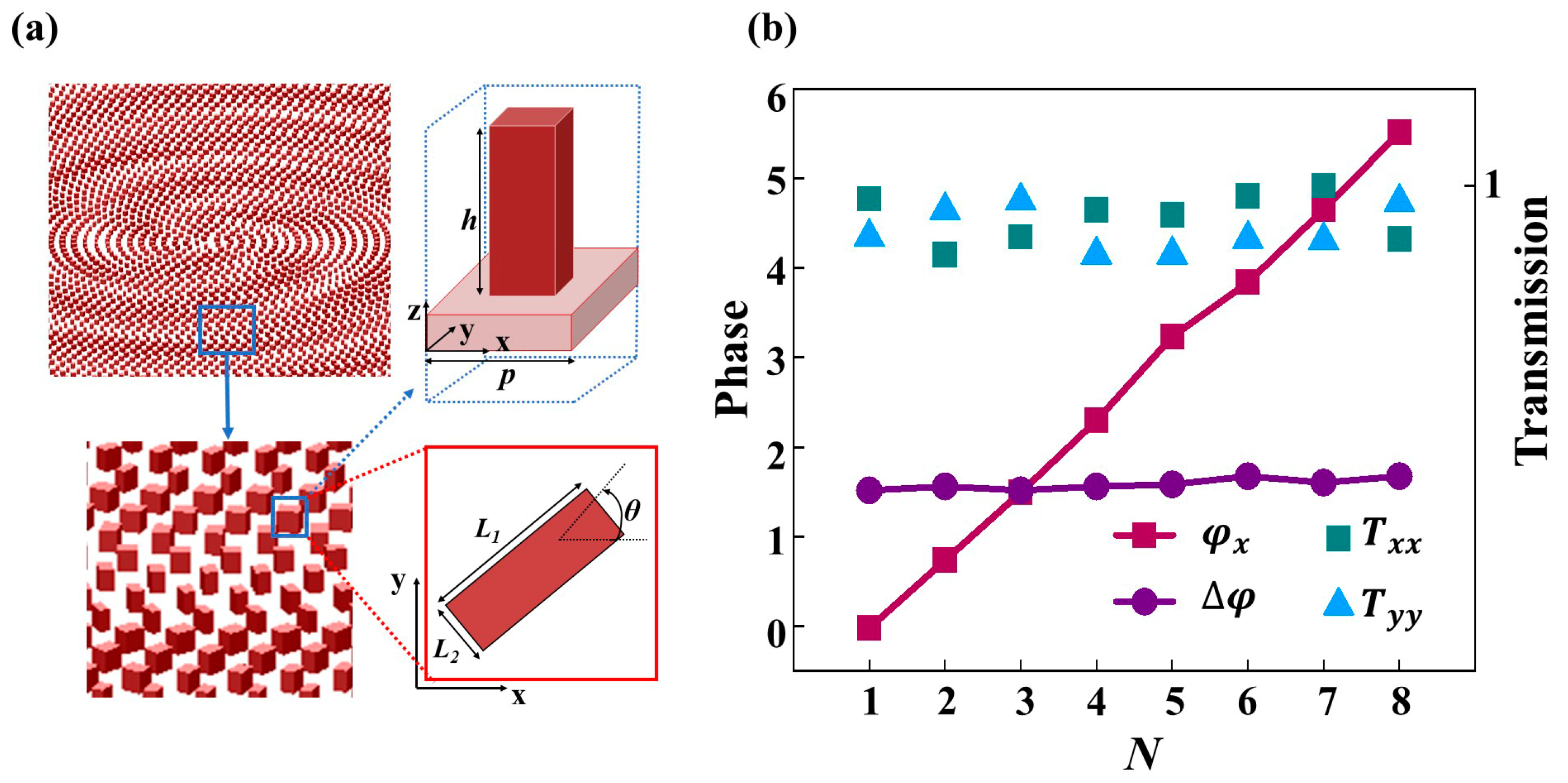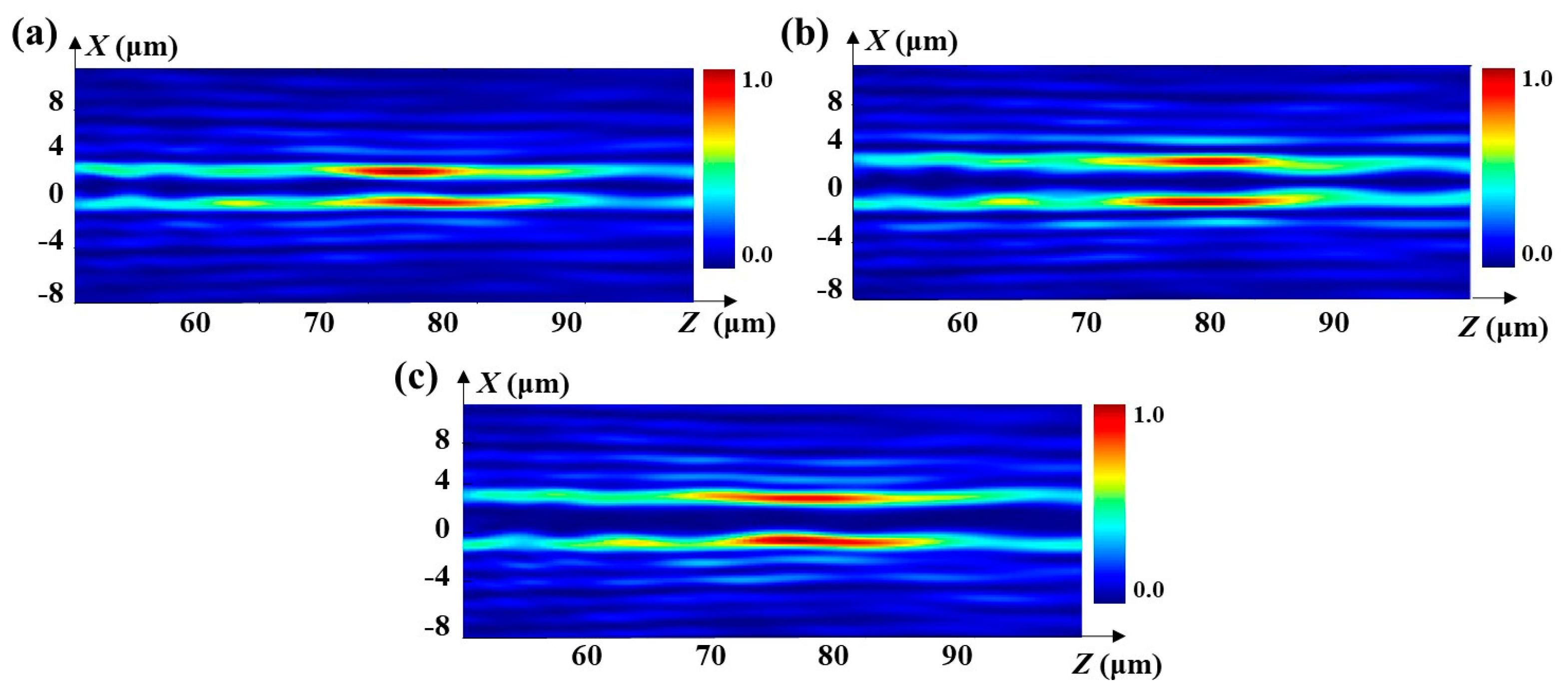Quarter-Wave Plate Meta-Atom Metasurfaces for Continuous Longitudinal Polarization Modulation of Hybrid Poincaré Sphere Beams
Abstract
:1. Introduction
2. Results
2.1. Concept of 3D HyOPS Beam
2.2. Working Principle and Numerical Calculation
2.3. Design of Meta-Atom and Metasurface
3. Simulation Results and Discussion
4. Conclusions
Author Contributions
Funding
Institutional Review Board Statement
Informed Consent Statement
Data Availability Statement
Conflicts of Interest
References
- Dixon, J.; Pan, F.; Moradifar, P.; Bordoloi, P.; Dagli, S.; Dionne, J. Through Thick and Thin: How Optical Cavities Control Spin. Nanophotonics 2023, 12, 2779–2788. [Google Scholar] [CrossRef] [PubMed]
- Rosales-Guzmán, C.; Ndagano, B.; Forbes, A. A Review of Complex Vector Light Fields and Their Applications. J. Opt. 2018, 20, 123001. [Google Scholar] [CrossRef]
- Long, X.; Wang, X.; Qing, Z.; Zhen, W.; Yuan, Z.; Gao, Y.; Yan, W.; Ren, Z.-C.; Wang, X.-L.; Ding, J.; et al. Fast Identification of Orbital-Angular-Momentum States in Vector Beams. Phys. Rev. Appl. 2024, 22, 044019. [Google Scholar] [CrossRef]
- Mi, S.; Chen, Y.; Gao, J.; Wang, G.; Chew, K.-H.; Chen, R.-P. Dynamic Manipulation of Orthogonal Polarization Components in a High-Resolution Twisted Vector Light Field with a Highly Scattering Medium. Opt. Lasers Eng. 2024, 176, 108069. [Google Scholar] [CrossRef]
- Pan, K.; Wu, X.; Li, P.; Liu, S.; Wei, B.; Li, D.; Yang, D.; Chen, X.; Zhao, J.; Wen, D. Cylindrical Vector Beam Holography without Preservation of OAM Modes. Nano Lett. 2024, 24, 6761–6766. [Google Scholar] [CrossRef]
- Zeng, X.; Li, Z.; Yang, X.; Xu, J.; Wang, J.; Wang, C.; Quan, Q.; Chen, H.; Wei, D.; Gao, H.; et al. Spatial Coherent Manipulation of Bessel-like Vector Vortex Beam in Atomic Vapor. New J. Phys. 2024, 26, 063029. [Google Scholar] [CrossRef]
- Zhang, K.; Wang, Y.; Burokur, S.N.; Wu, Q. Generating Dual-Polarized Vortex Beam by Detour Phase: From Phase Gradient Metasurfaces to Metagratings. IEEE Trans. Microw. Theory Technol. 2022, 70, 200–209. [Google Scholar] [CrossRef]
- Milione, G.; Sztul, H.I.; Nolan, D.A.; Alfano, R.R. Higher-Order Poincaré Sphere, Stokes Parameters, and the Angular Momentum of Light. Phys. Rev. Lett. 2011, 107, 053601. [Google Scholar] [CrossRef]
- Yi, X.; Liu, Y.; Ling, X.; Zhou, X.; Ke, Y.; Luo, H.; Wen, S.; Fan, D. Hybrid-Order Poincaré Sphere. Phys. Rev. A 2015, 91, 023801. [Google Scholar] [CrossRef]
- Lv, H.; He, R.; Yan, L.; Pang, L.; Kong, Y. Experimental Generation and Orbital Angular Momentum Properties of Focused Field for Vector Vortex Beams on Hybrid-Order Poincaré Sphere. Opt. Commun. 2022, 519, 128425. [Google Scholar] [CrossRef]
- Kumar, S.; Saripalli, R.K.; Ghosh, A.; Buono, W.T.; Forbes, A.; Samanta, G.K. Controlling the Coverage of Full Poincaré Beams through Second-Harmonic Generation. Phys. Rev. Appl. 2023, 19, 034082. [Google Scholar] [CrossRef]
- Li, S.J.; Han, B.W.; Li, Z.Y.; Liu, X.B.; Huang, G.S.; Li, R.Q.; Cao, X.Y. Transmissive Coding Metasurface with Dual-Circularly Polarized Multi-Beam. Opt. Express 2022, 30, 26362–26376. [Google Scholar] [CrossRef] [PubMed]
- Chong, K.E.; Wang, L.; Staude, I.; James, A.R.; Dominguez, J.; Liu, S.; Subramania, G.S.; Decker, M.; Neshev, D.N.; Brener, I.; et al. Efficient Polarization-Insensitive Complex Wavefront Control Using Huygens’ Metasurfaces Based on Dielectric Resonant Meta-Atoms. ACS Photonics 2016, 3, 514–519. [Google Scholar] [CrossRef]
- Liu, M.; Huo, P.; Zhu, W.; Zhang, C.; Zhang, S.; Song, M.; Zhang, S.; Zhou, Q.; Chen, L.; Lezec, H.J.; et al. Broadband Generation of Perfect Poincaré Beams via Dielectric Spin-Multiplexed Metasurface. Nat. Commun. 2021, 12, 2230. [Google Scholar] [CrossRef] [PubMed]
- Kruk, S.S.; Wang, L.; Sain, B.; Dong, Z.; Yang, J.; Zentgraf, T.; Kivshar, Y. Asymmetric Parametric Generation of Images with Nonlinear Dielectric Metasurfaces. Nat. Photon. 2022, 16, 561–565. [Google Scholar] [CrossRef]
- Kamali, S.M.; Arbabi, E.; Arbabi, A.; Horie, Y.; Faraon, A. Highly Tunable Elastic Dielectric Metasurface Lenses. Laser Photonics Rev. 2016, 10, 1002–1008. [Google Scholar] [CrossRef]
- Fan, Q.; Liu, M.; Zhang, C.; Zhu, W.; Wang, Y.; Lin, P.; Yan, F.; Chen, L.; Lezec, H.J.; Lu, Y.; et al. Independent Amplitude Control of Arbitrary Orthogonal States of Polarization via Dielectric Metasurfaces. Phys. Rev. Lett. 2020, 125, 267402. [Google Scholar] [CrossRef]
- Zhang, Z.; Gu, M.; Cui, G.; Zhou, Y.; Dong, Q.; Gao, S.; Choi, D.-Y.; Cheng, C.; Liu, C. Manipulations of Vectorial-Structured Light by Spatially Interleaved Metasurfaces of Quarter-Wave-Plate Meta-Atoms. J. Light. Technol. 2024, 42, 6863–6873. [Google Scholar] [CrossRef]
- Cui, G.; Gu, M.; Cheng, C.; Zhang, Z.; Zhou, Y.; Dong, Q.; Gao, S.; Choi, D.-Y.; Cheng, C.; Liu, C. Multifunctional All-Dielectric Quarter-Wave Plate Metasurfaces for Generating Focused Vector Beams of Bell-like States. Nanophotonics 2024, 13, 1631–1644. [Google Scholar] [CrossRef]
- Gu, M.; Cheng, C.; Zhan, Z.; Zhang, Z.; Cui, G.; Zhou, Y.; Zeng, X.; Gao, S.; Choi, D.-Y.; Cheng, C.; et al. Dielectric Supercell Metasurfaces for Generating Focused Higher-Order Poincaré Beams with the Residual Copolarization Component Eliminated. ACS Photonics 2024, 11, 204–217. [Google Scholar] [CrossRef]
- Gu, M.; Zhang, R.; Cheng, C.; Dong, Q.; Zeng, X.; Zhang, Y.; Zhan, Z.; Liu, C.; Cheng, C. Metasurfaces for Generating Higher-Order Poincaré Beams by Polarization-Selective Focusing and Overall Elimination of Co-Polarization Components. Opt. Express 2023, 31, 38921–38938. [Google Scholar] [CrossRef] [PubMed]
- Balthasar Mueller, J.P.; Rubin, N.A.; Devlin, R.C.; Groever, B.; Capasso, F. Metasurface Polarization Optics: Independent Phase Control of Arbitrary Orthogonal States of Polarization. Phys. Rev. Lett. 2017, 118, 113901. [Google Scholar] [CrossRef]
- Cai, J.; Zhang, F.; Pu, M.; Chen, Y.; Guo, Y.; Xie, T.; Feng, X.; Jiang, B.; Ma, X.; Li, X.; et al. Dispersion-Enabled Symmetry Switching of Photonic Angular-Momentum Coupling. Adv. Funct. Mater. 2023, 33, 2212147. [Google Scholar] [CrossRef]
- Wang, Y.; Yue, W.; Gao, S. Dielectric Diatomic Metasurface-Assisted Versatile Bifunctional Polarization Conversions and Incidence-Polarization-Secured Meta-Image. Opt. Express 2023, 31, 29900–29911. [Google Scholar] [CrossRef] [PubMed]
- Li, J.; Yang, L.-J. Focused Vortex and Imaging Full-Space Metasurface. Opt. Commun. 2023, 535, 129318. [Google Scholar] [CrossRef]
- Yang, J.; Zhao, R.; Li, Y.; Tian, C.; Ji, X.; Li, X.; Li, J.; Wang, Y.; Huang, L. Transformation of Longitudinally Customizable Curved Vector Vortex Beams Using Dielectric Metasurface. Laser Photonics Rev. 2024, 18, 2400226. [Google Scholar] [CrossRef]
- Wang, M.; Chen, L.; Choi, D.-Y.; Huang, S.; Wang, Q.; Tu, C.; Cheng, H.; Tian, J.; Li, Y.; Chen, S.; et al. Characterization of Orbital Angular Momentum Quantum States Empowered by Metasurfaces. Nano Lett. 2023, 23, 3921–3928. [Google Scholar] [CrossRef]
- Wen, D.; Yue, F.; Li, G.; Zheng, G.; Chan, K.; Chen, S.; Chen, M.; Li, K.F.; Wong, P.W.H.; Cheah, K.W.; et al. Helicity Multiplexed Broadband Metasurface Holograms. Nat. Commun. 2015, 6, 8241. [Google Scholar] [CrossRef]
- Li, H.; Duan, S.; Zheng, C.; Li, J.; Xu, H.; Song, C.; Yang, F.; Liu, Y.; Shi, W.; Zhang, Y.; et al. Longitudinal Manipulation of Scalar to Vector Vortex Beams Evolution Empowered by All-Silicon Metasurfaces. Adv. Opt. Mater. 2023, 11, 2301368. [Google Scholar] [CrossRef]
- Zheng, C.; Li, J.; Liu, J.; Li, J.; Yue, Z.; Li, H.; Yang, F.; Zhang, Y.; Zhang, Y.; Yao, J. Creating Longitudinally Varying Vector Vortex Beams with an All-Dielectric Metasurface. Laser Photonics Rev. 2022, 16, 2200236. [Google Scholar] [CrossRef]
- Wang, W.-Y.; Guo, J.-X.; Liu, S.; Lü, J.-Q.; Lu, Z.-W. Manipulating the Variation of Polarization during Propagation along Arbitrary Circular Trajectory of the Poincaré Sphere. Appl. Phys. Lett. 2022, 121, 161102. [Google Scholar] [CrossRef]
- Guo, J.-X.; Li, J.-S.; Wang, Y.; Lü, J.-Q.; Lu, Z. Self-Healing Propagation of a Longitudinally Varying Vector Optical Beam for Distance Measurement. Opt. Lett. 2024, 49, 2825–2828. [Google Scholar] [CrossRef] [PubMed]
- Dorrah, A.H.; Rubin, N.A.; Zaidi, A.; Tamagnone, M.; Capasso, F. Metasurface Optics for On-Demand Polarization Transformations along the Optical Path. Nat. Photonics 2021, 15, 287–296. [Google Scholar] [CrossRef]
- He, X.; Bao, H.; Zhang, F.; Kang, T.; Pu, M.; Chen, Y.; Guo, Y.; Gong, J.; Xu, M.; Luo, X. Longitudinally Continuous Varying High-Order Cylindrical Vector Fields Enabled by Spin-Decoupled Metasurfaces. Nanophotonics 2024, 13, 1657–1664. [Google Scholar] [CrossRef] [PubMed]
- Wang, W.-Y.; Li, J.-S.; Guo, J.-X.; Lv, J.-Q. Research progress of vector optical beam with longitudinally varying polarization (invited). Infrared Laser Eng. 2023, 52, 20230362. [Google Scholar] [CrossRef]
- Yuan, Y.; Zhang, K.; Ratni, B.; Song, Q.; Ding, X.; Wu, Q.; Burokur, S.N.; Genevet, P. Independent Phase Modulation for Quadruplex Polarization Channels Enabled by Chirality-Assisted Geometric-Phase Metasurfaces. Nat. Commun. 2020, 11, 4186. [Google Scholar] [CrossRef]
- Zang, H.; Zhou, X.; Yang, Z.; Yu, Q.; Zheng, C.; Yao, J. Polarization Multiplexed Multifunctional Metasurface for Generating Longitudinally Evolving Vector Vortex Beams. Phys. Lett. A 2024, 497, 129336. [Google Scholar] [CrossRef]
- Aieta, F.; Genevet, P.; Kats, M.A.; Yu, N.; Blanchard, R.; Gaburro, Z.; Capasso, F. Aberration-Free Ultrathin Flat Lenses and Axicons at Telecom Wavelengths Based on Plasmonic Metasurfaces. Nano Lett. 2012, 12, 4932–4936. [Google Scholar] [CrossRef]
- Zhang, Y.; Liu, W.; Gao, J.; Yang, X. Generating Focused 3D Perfect Vortex Beams By Plasmonic Metasurfaces. Adv. Opt. Mater. 2018, 6, 1701228. [Google Scholar] [CrossRef]





Disclaimer/Publisher’s Note: The statements, opinions and data contained in all publications are solely those of the individual author(s) and contributor(s) and not of MDPI and/or the editor(s). MDPI and/or the editor(s) disclaim responsibility for any injury to people or property resulting from any ideas, methods, instructions or products referred to in the content. |
© 2025 by the authors. Licensee MDPI, Basel, Switzerland. This article is an open access article distributed under the terms and conditions of the Creative Commons Attribution (CC BY) license (https://creativecommons.org/licenses/by/4.0/).
Share and Cite
Li, Y.; Feng, Q.; Fang, G.; Sun, H.; Fan, X.; Liu, Z.; Wang, H.; Si, Y.; Si, S.; Li, X.; et al. Quarter-Wave Plate Meta-Atom Metasurfaces for Continuous Longitudinal Polarization Modulation of Hybrid Poincaré Sphere Beams. Photonics 2025, 12, 242. https://doi.org/10.3390/photonics12030242
Li Y, Feng Q, Fang G, Sun H, Fan X, Liu Z, Wang H, Si Y, Si S, Li X, et al. Quarter-Wave Plate Meta-Atom Metasurfaces for Continuous Longitudinal Polarization Modulation of Hybrid Poincaré Sphere Beams. Photonics. 2025; 12(3):242. https://doi.org/10.3390/photonics12030242
Chicago/Turabian StyleLi, Yunxiao, Quanhong Feng, Gongzheng Fang, Haonan Sun, Xingyi Fan, Zhenghao Liu, Hao Wang, Yuexu Si, Shuhao Si, Xuran Li, and et al. 2025. "Quarter-Wave Plate Meta-Atom Metasurfaces for Continuous Longitudinal Polarization Modulation of Hybrid Poincaré Sphere Beams" Photonics 12, no. 3: 242. https://doi.org/10.3390/photonics12030242
APA StyleLi, Y., Feng, Q., Fang, G., Sun, H., Fan, X., Liu, Z., Wang, H., Si, Y., Si, S., Li, X., & Cheng, C. (2025). Quarter-Wave Plate Meta-Atom Metasurfaces for Continuous Longitudinal Polarization Modulation of Hybrid Poincaré Sphere Beams. Photonics, 12(3), 242. https://doi.org/10.3390/photonics12030242






